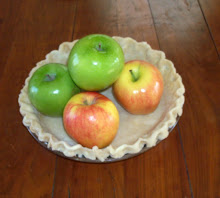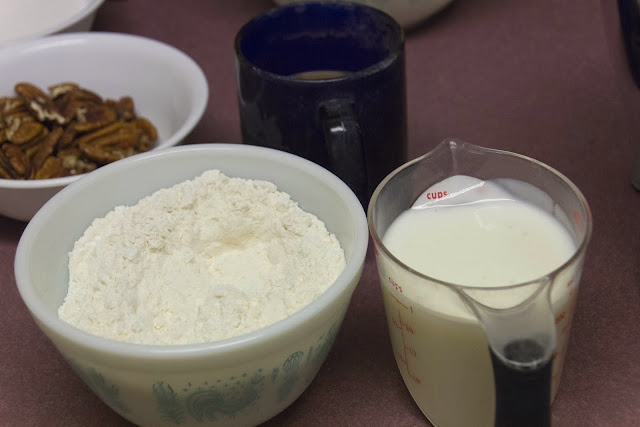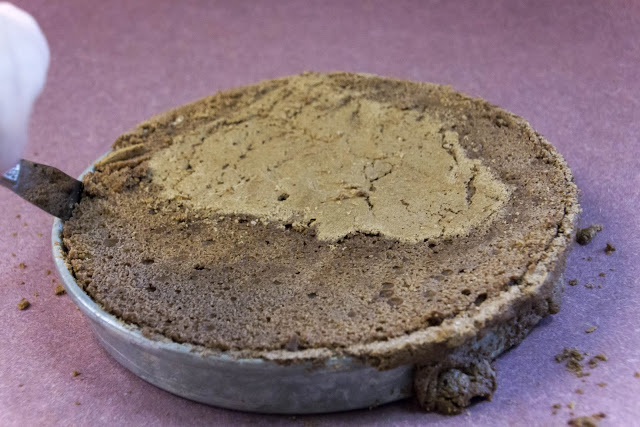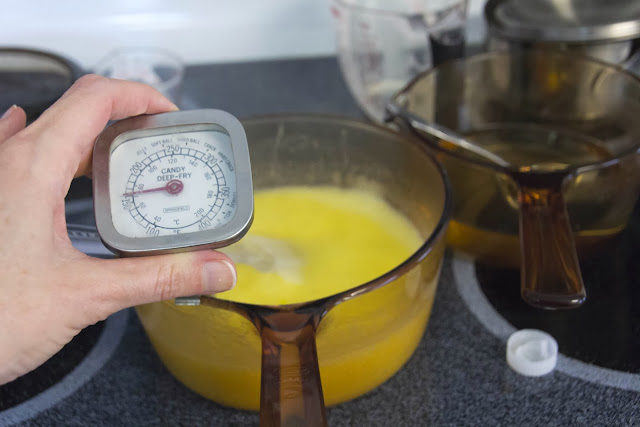Last fall, a good friend threw a party to celebrate his 25th and his sister's 35th birthdays. He mentioned that he wanted to bake a German Chocolate Cake, but a few days later, he said that he wouldn't have time. It wasn't a surprise since he has a busy work and school schedule. And it wasn't a surprise that I offered to pick up the slack since we all know I love to bake.
The first challenge with this project was time. This friend is a fellow grad student, so his busy schedule is similar to my busy schedule. The party was on Friday night, and Thursday night was class night, leaving no time to bake. The plan for Thursday: bake the cake before work, and come home over lunch to make the filling and frosting. The Friday plan: come home at lunch to fill the cake and apply the first layer of frosting. Friday evening before the party: finish the frosting.
The second challenge was that I've never made a German Chocolate Cake before (BTW, they're not German. The recipe was developed by an American whose last name was German). The solution was to pick a recipe from a trustworthy source. I used David Lebovitz's recipe, which was also posted on Brown Eyed Baker. With two such fine endorsements, what could go wrong? Well, as you will soon learn, two things went wrong.
And the final challenge was that I really cared about the outcome. Grad school is no fun, and this person is on the team of fellow sufferers who have helped me make it all the way to the last semester without medication. He's on the "friends help you move, real friends help you move bodies" list.
This post is less of a tutorial on how to bake the perfect German chocolate cake than a real world example of how to bake with limited time and how to cope when things go wrong. If you follow along on my journey, I guarantee that you will end up with a delicious cake, hopefully without my particular disasters. And hopefully you have wonderful friends to share it with, which is really what this is all about.
Ingredients
(Adapted from David Lebovitz)
(Adapted from David Lebovitz)
- Cake:
- 2 ounces unsweetened chocolate (I used 6 tablespoons cocoa powder mixed with 2 tablespoons vegetable oil)
- 6 tablespoons water
- 2 ounces bittersweet or semisweet chocolate
- 2 sticks room temperature unsalted butter
- 1 ¼ cup + ¼ cup sugar
- 4 large eggs, separated
- 2 cups all-purpose flour
- 1 teaspoon baking powder
- 1 teaspoon baking soda
- ½ teaspoon salt
- 1 cup buttermilk, room temperature
- 1 teaspoon vanilla
- Filling:
- 1 cup cream
- 1 cup sugar
- 3 large egg yolks
- 6 tablespoons butter
- ½ teaspoon salt
- 1 cup pecans
- 1⅓ cups coconut
- Syrup:
- 1 cup water
- ¾ cup sugar
- 2 tablespoons rum
- Frosting:
- 8 ounces bittersweet or semisweet chocolate
- 2 tablespoons corn syrup
- 3 tablespoons unsalted butter
- 1 cup heavy cream
Method
On Wednesday night, I measured everything out. I mixed the dry ingredients (flour, baking soda, baking powder, salt) together, separated the eggs, and cut out parchment paper to line the cake pans. At 6:00AM on Thursday morning, I started brewing coffee and pulled the cold ingredients out of the refrigerator. Everything was ready to go.
The original recipe called for baking chocolate, which I don't keep around the house. As a substitute, I mixed unsweetened cocoa with vegetable oil.
Add water.
Stir to combine.
Add semi-sweet chocolate. Heat in the microwave until the chocolate is melted, stir, and let it come down to room temperature.
Pour four egg whites into the mixer.
And beat them until they held soft peaks.
Add ¼ cup of sugar and beat until stiff.
Set egg whites and sugar aside.
Beat the butter and 1¼ cups sugar for five minutes.
Add the chocolate and beat until combined.
Mix in the egg yolks one at a time.
Lightly mix in half of the flour mixture. Mix in the buttermilk and vanilla. Add the remaining half of the flour mixture.
Stir in the egg whites until just combined.
Butter the cake pans and line them with parchment paper (I cut out the parchment paper the night before).
The original recipe called for baking at 350° F for 45 minutes. However, I didn't do that. My cakes have a tendency to dome, and long ago I'd read that baking them under temperature can fix that. So I baked them at 300° F for 70 minutes (until a toothpick inserted into the cake comes out clean). Did I sit around a twiddle my thumbs while they were baking? No, I did not. As the smell of chocolate began to waft throughout the house, I took care of my weekly housecleaning and grabbed a quick workout. Grad school teaches you to do routine things at odd times.
So far everything had gone according to plan. Which meant it was time for disaster to strike. Problem #1 in this saga: the cake batter overflowed in the oven. Badly. My heart sank. I didn't know if the project could be salvaged, and there was no time to bake another batch of cakes. I let them sit just long enough to slightly cool, and them dropped them into the refrigerator and went to work.
I picked the project up again when I came home from lunch. Emboldened by some quick internet research, I grabbed a knife with a serrated blade and hopped for the best.
Sure enough, the best came to pass. I held my hand over the top of the cake while slicing though to make the cake level with the top of the pan.
With moderate difficulty, I ran a knife around the edge to remove the cake from the pan. Again, success.
Now the hardest part. With my history of cake decorating disasters, would I be able to slice the cake into even layers? I scored small cuts around the base of the cake at the half way point, and then held the top while gradually circling in from the edge into the center.
Much to my amazement, I came away with four perfectly even layers. The project was saved. I wrapped the layers in plastic and returned them to the fridge for safekeeping.
I ran the pecans and coconut through the regular toast setting on my toaster oven. (Try a 350° oven for 5-7 minutes if you don't have a toaster oven or don't want to be that casual in your baking projects. Watch closely so that the end result is toasted and not burned.)
Chop the pecans.
Mix the pecans, coconut, and butter in a large bowl, set aside.

Whisk the cream, egg yolks, and sugar in a saucepan on medium heat.
Heat the mixture to 270°, stirring constantly.
Pour the custard over the pecans, coconut, and butter.
Stir until the butter melts and set aside.
To make the syrup, combine the water and sugar in a saucepan on medium heat and stir until fully dissolved. Remove from heat and stir in the rum (it's about time for alcohol to make an appearance in this project).
Next comes frosting. Heat the cream to boiling. Get the chocolate, corn syrup, and butter ready in a bowl.
Pour the boiling cream over the chocolate mixture. Let stand for a minute and then stir until everything melts. At this point, I packed up everything in the fridge and went back to work.
I placed the base layer of the cake on the plate and liberally brushed it with the rum syrup.
I heaped on ¾ cup of filling and spread it out to the sides.
Next came layer two, with a repeat of brushed syrup and filling.
And then layer three.
And finally layer four.
The next step was to apply the crumb coat of frosting. I was worried that the frosting would be too stiff to work with after a day in the fridge, but it spread easily (a forewarning of disaster #2). I covered the cake and packed the project up in the fridge again.
Friday night rolled around and I was ready to finish the project. I piled on the frosting.
And smoothed it out with a frosting spatula.
Now it was time to pipe a decorative border around the top of the cake.
Cue disaster #2. The frosting was too soft to hold the shape. Out of 100+ comments on Brown Eyed Baker, only one other person mentioned this problem, and the advice was to let the frosting chill. Mine had been in the fridge for a good 6 hours at that point. I tried freezing it, but the soft consistency returned after a few minutes at room temperature. It was almost time to leave for the party, so what to do?
I solved the problem the only way I could: by smoothing everything out. If I had it all to do again, I suppose a better solution would have been to cover the entire top with chocolate. Ah, hindsight.
The wax paper strips were removed, and the cake was ready to travel.
And we had a wonderful evening.
















































